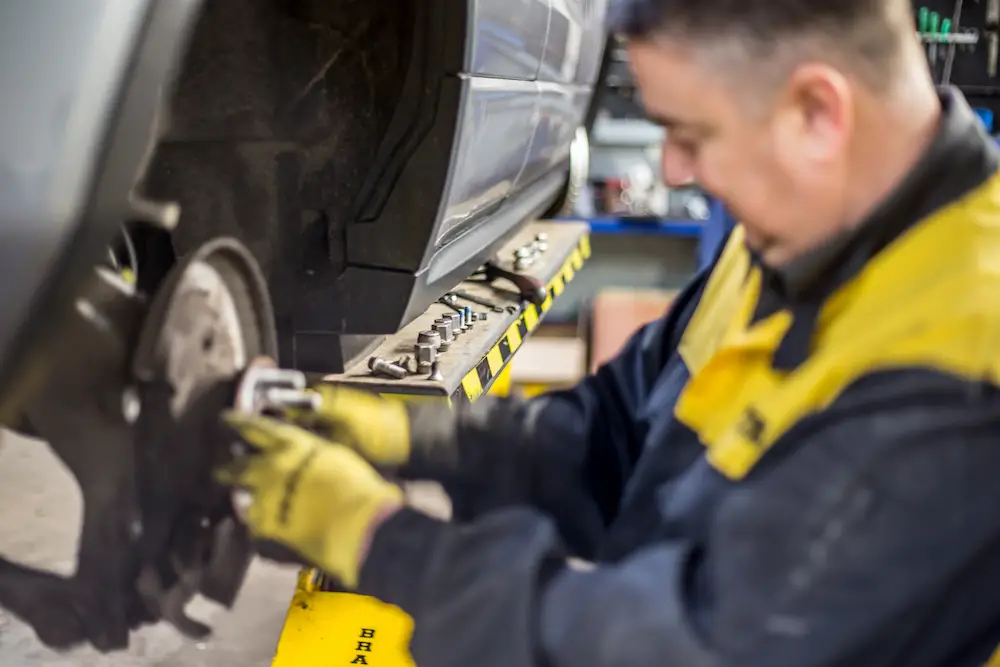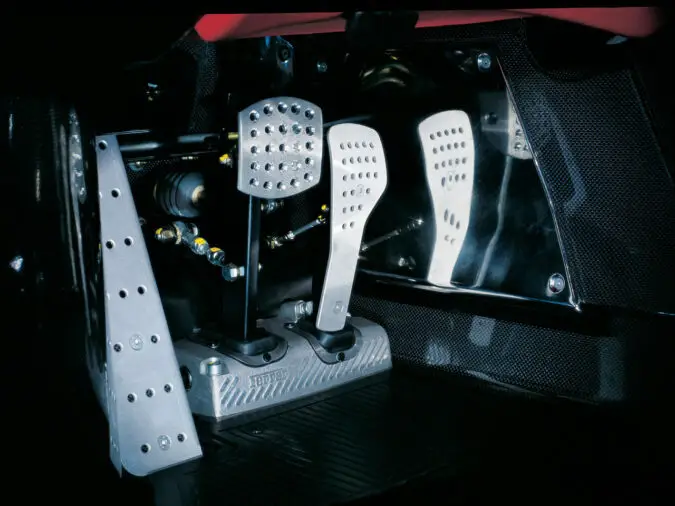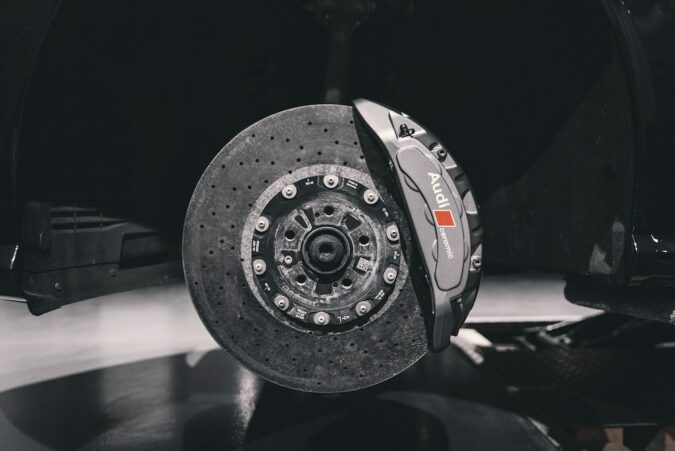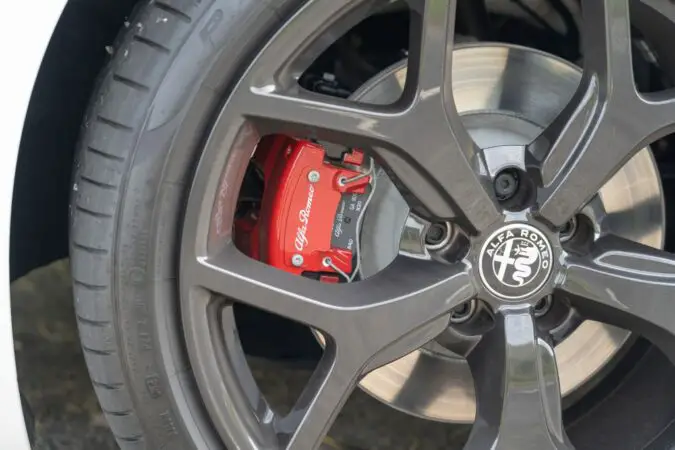Bleeding your car’s brakes sounds weird, doesn’t it? Do they even have blood? Well, sort of. Lousy joke attempt aside, bleeding your brake is necessary from time to time. It makes sure your brakes work well and keep you safe. So, how much to bleed brakes? It’s actually quite cheap, the highest estimate is no more than $150.
Of course, some of you may not be familiar with the process. Here’s everything you need to know about bleeding your car’s brake:
How Your Car’s Braking System Works
To understand why you need to bleed the brakes in your car, it’s best to understand how your car’s braking system works. Of course, if you already know how it works, you can skip this section entirely. But for those of you who don’t know, here’s how it works:
There are several types of braking systems, but cars commonly use a hydraulic system. Chances are, this is what your car uses. The system has many components, but we can break it down into several main ones:
- Brake booster
- Master cylinder
- Brake fluid
- Brake lines
- Calipers and brake pads
- Rotors (or drums in some cars)
So, how do they work? Well, it starts when you press the brake pedal in your car which activates the brake booster to multiply the pressure.
The master cylinder then converts mechanical pressure into hydraulic pressure, which then forces the brake fluid to travel. The brake fluid will then travel through the brake lines, which is usually a rubber hose that connects the master cylinder to the individual brake system in each wheel.
When the brake fluid reaches the calipers, it will apply pressure to them. This will cause the calipers – and the brake pads within them – to come into contact with the rotors. As a result, the rotors will slow down and therefore your wheels will slow down until you relieve the pressure from the brake pedal.
Drum brakes also use a hydraulic system to operate. The only difference is that they force the brake shoes (pads) from the inside of the drum, rather than applying pressure outside of it. Pretty simple, no? As mentioned, there are more components in the system such as the ABS system and wheel speed sensors, but they’re not relevant to our topic.
Other Types Of Braking Systems
The hydraulic braking system is the only system that requires bleeding from time to time. Therefore, other types of braking systems are not relevant to this topic. So, we’re only going to briefly mention them just for your general knowledge. There are two other types of braking systems:
- Electromagnetic braking system. As the name suggests, this system uses magnets to slow down your wheels and controls them electronically. Some cars that use this include the Toyota Prius, Lexus RX400h, and the C8 Corvette. Some people may refer to them as the brake-by-wire system.
- Mechanical braking system. This system uses mechanical linkages such as rods or springs to apply pressure to the calipers rather than a hydraulic system. This is usually the system used for the hand brake or emergency brake.
So, now you know how the hydraulic system works and other types of braking systems. But why does the hydraulic system need to be bled? Well, that segues us nicely to our next section:
How Much To Bleed Brakes: Why Bleed Them?
As mentioned, bleeding the brakes will keep your braking system in good shape and keep you safe. But why is that exactly? Well, the main reason to bleed your car’s brakes is to remove any trapped air or moisture from the brake lines (or if you know how to get air out of brake lines without bleeding).
When there’s air or moisture in the brake lines, this disrupts the flow of the brake fluid in the system. If the fluid isn’t flowing correctly, this will reduce the hydraulic pressure of the entire system. Ultimately this will result in less braking pressure, which can decrease your brake’s effectiveness and increase your car’s stopping distance.
In severe cases, the brake fluid may not reach the calipers at all. This means your calipers won’t engage the rotors, and your brakes essentially don’t work. I don’t know about you but I like my brakes to work whenever I’m driving, so this is as good as any reason to bleed the brakes.
Here’s a tip: if your brakes don’t work when you press the pedal, pump the pedal a few times. This will help the brake fluid to reach the calipers and engage the brakes. You should feel pressure on the pedal after about three pumps. If the pressure is gone, pump the pedals again.
This goes without saying, as soon as you notice there’s something wrong with the brakes, you should go to a repair shop immediately and fix the problem. Even if you can pump the brakes, it’s only a matter of time until they stop working completely.
How Does Air Enter The System?
The braking system is designed to be air-tight. However, there might be scenarios where air can enter it, such as when you replace the brake pads in the calipers. It may also enter the system when you open the brake fluid reservoir.
Topping up the brake fluid is unnecessary since it’s a closed system. Unless of course, you have a leak in the system. So, don’t open the brake fluid reservoir to prevent air and moisture from entering. The reservoir usually sits near the car’s firewall. It has a black cap on it with a yellow emergency brake icon on it.
Additionally, you may have a leak somewhere in the brake lines. This leak will not only allow brake fluid to escape (which will reduce braking effectiveness) but also allow air to enter and cause even more problems.
When Do I Need To Bleed My Brakes?
So, the question now is when do you need to bleed your car’s brakes? Unlike, say, changing the brake pads, there are no recommended intervals as to when to bleed your brakes. However, these are the signs that you need to bleed your brakes:
- The brake pedal feels spongy. When you press the brake pedal, you should feel sustained pressure. If there’s no consistent pressure, this is what we call a spongy brake pedal. You often need to press the pedal deeper to engage the brakes. This is the main sign that you have air in the brake lines and you need to bleed the system.
- No brake resistance or pressure at all. This is basically a much more severe version of a spongy brake pedal. In this case, you won’t feel pressure or resistance from the pedal no matter how much you press it. This may be due to a leak or a fault in the system, but a massive amount of trapped air can also cause this.
Air in the system will not trigger the check brake lights, so you’ll have to pay attention to your car’s braking performance to know when to bleed the brakes. In any case, a decrease in braking performance is not to be taken lightly. In addition to the signs, here are also some other times that we recommend that you bleed the system:
- There’s a leak in the system. In this case, you’ll also need to replace the leaking part.
- After changing the brake pads or doing other maintenance or repairs to the braking system.
- Once a year as preventive maintenance.
So, that’s everything about the braking system. From how it works, to why and when you need to bleed the brakes. Now, let’s break down the cost a bit further:
How Much To Bleed The Brakes?
As mentioned, bleeding your car’s brakes will usually cost no more than $150 at most. It’s usually anywhere between $110 – $150 for most cars. The labor will cost around $90, and you will need to pay around another $20 for new brake fluids to put in the system. Of course, some cars may cost more, especially luxury and performance cars.
Can I Do It Myself?
The cost is fairly cheap, but can you do it yourself to save money on labor costs? You can, but we must warn you that it may be difficult if you’re not mechanically inclined. Additionally, the braking system is crucial for your safety in the car, and we don’t really recommend you to DIY repairs related to safety if you’re not entirely sure.
My two cents is that it’s best to leave this job to a professional. I once tried doing it myself and I didn’t enjoy the process and would’ve preferred to have someone do it for me.
Anyway, if you want to do this yourself, you’ll need a friend to help you. And you’ll also need these things:
- A turkey baster.
- An open-ended wrench.
- An empty bottle and a hose.
- New brake fluids – check your owner’s manual to find the right fluid for your car.
Now, with the things above in hand and a friend by your side, here are the steps to bleed your brakes:
How To Bleed Brakes
- Put your car on jack stands and remove the wheels. This isn’t necessary but it will make accessing the bleeder valves a lot easier.
- Locate the bleeder valve, remove the rubber cover, and then connect it to your hose.
- Remove as much fluid as possible first from the master cylinder. Check your owner’s manual to find the master cylinder. Open it, and then use the turkey baster to suck them out and put them in the empty bottle.
- Refill the master cylinder with the new brake fluid.
- This is where you need a friend to press the brake pedal. Open the valve, and tell your friend to press the brake.
- Close the valve and tell them to let go of the brakes. Repeat this process several times.
- After about every five pumps, inspect the fluid level on the master cylinder and the fluid in the bleed hose. Add more fluid into the master cylinder if necessary. Also check the fluid in the bleed hose, if the fluid is clear and there aren’t any air bubbles, move on to the other wheels. Reinstall the rubber cover on the bleeder valve once you’re done.
- Move to the next line, and repeat steps 2 – 7.
- After you’re done bleeding all the lines, check the fluid level at the master cylinder. Refill it with new fluid until it reaches the maximum indicator.
- You’re done! Turn on the car and test the brake pedal, if there’s pressure, then it’s working fine.
The process is quite lengthy, you can see why I didn’t recommend it in the first place. If you need a visual guide, I recommend watching the video above from ChrisFix. He explains how to do this very clearly and will help you should you decide to do this little project yourself.
How Much To Bleed The Brakes: Questions And Answers
Your car’s braking system is very complex and we’ve only talked about its basics. If you still have any brake-related questions, check out the FAQ below:
Can I Reuse The Old Brake Fluid?
No, you can’t. You shouldn’t use a brake fluid that has been sitting in an open container either. This is because brake fluid can be easily contaminated by dust, air, and moisture. These things will react badly and corrode your car’s brake system.
Once you’ve opened the container, make sure to put the cap back on and seal it tight. You can still use this bottle afterward, but most manufacturers recommend that you use it within 12 months. After that, you need to buy a new bottle.
Is It Necessary To Bleed The Brakes Once A Year?
Not really, but there’s no harm in doing it. The key thing is once you feel the brake pedal feels spongy or your brakes don’t work properly, then address it immediately.
When Do I Need To Change The Brake Fluid?
If the system is working fine, then usually once every two or three years is fine. But if there’s a leak in the system, then you’ll need to address that and change the fluid in the process as well.
Again, the key thing here is to pay attention to your brake pedal feel and brake performance. If there’s no pressure or your brakes don’t feel quite as good, then you need to check the system.
You can also check if your brake fluid needs topping up by inspecting the reservoir. They have a maximum and minimum indicator, and you can inspect them without opening them.
If it’s below the minimum level, you should fill it up. However, a brake system is a closed-loop system. Meaning it’s not supposed to lose fluid, at least not quickly. If you’re rapidly losing brake fluid, this means there’s a leak in the system that you should fix.
When Should I Replace My Brake Pads?
Brake pads typically need to be replaced every 10,000 to 20,000 miles. But you may need to change it sooner than later if you tend to abuse your brakes. Here are the signs to look out for:
- You hear a squealing noise when you press the brake pedal.
- The car pulls to one side when you brake. This can also mean that one of the brake lines isn’t working properly, therefore one side of the brakes isn’t engaging.
- There’s a grinding noise and vibration when you brake.
These are the signs that your brake pads have worn out and need to be replaced. Keep in mind that the worn-out rotors have similar symptoms, but they usually last until 50,000 miles before you need to replace them.
Brake pads typically cost between $110 – $300 to replace per axle (two wheels) including labor. Meanwhile, the rotors are usually around $150 – $200 per axle including labor.
Keep in mind you can resurface the rotors to save money. This process smoothens the surface of the rotor so it works almost like new, and usually costs around $50 per rotor. However, this won’t work if the rotors are bent or have warped.
How Much Do Brake Lines Cost?
Another component in the system that may need replacing is the brake lines. As mentioned, this is the hose that connects the master cylinders to the individual brakes.
They’re usually made from rubber, and they can puncture or flex over time which will reduce braking performance. It usually costs between $150 – $200 to replace brake lines including labor.
Note that there are other brake lines made from steel, carbon fiber, kevlar, and even Teflon. They each have their benefits but will cost more. In most cases, it’s not necessary to upgrade your brake lines.
However, if you often abuse your brakes or you go offroading quite often, you will benefit greatly from these higher-performance brake lines. Read our article about brake line replacement costs to learn more.
What Can I Do To Maintain My Brakes?
There’s not much you can do to prolong the lifespan of your brake pads and rotors. But to maintain the system as a whole, here are some things you should do:
- Inspect the rotors, calipers, and pads once a year. If you don’t understand how to, ask your mechanic to check them during a big service. They will be able to tell you the condition of your brakes.
- Pay attention to your brake pedal and braking performance. If they feel spongy or they don’t feel quite right, find out the problem and repair it to prevent any further damage.
- Avoid sudden and hard braking, this will wear out your pads and rotors much quicker. Keep a safe distance from the car in front, so you can coast and apply gentle pressure to the brakes.
That’s about it, that’s all you can do to preserve and prolong the lifespan of your brake system.
What Does The ‘ABS’ Light On My Dashboard Mean?
You may see a light on the dashboard that says ‘ABS’. ABS stands for Anti-lock Braking System, which is the device that prevents your car’s wheels from locking when you brake hard. But the warning light on the dashboard indicates that the car has a chassis-related error.
This can mean several things, from a faulty ABS system, a low brake fluid, and wheel speed sensor errors among others. In any case, you don’t want to ignore this as it can be very serious and can affect your car’s performance and safety.
If the cause isn’t obvious, you can check what’s wrong with the car by plugging an OBD scanner into the car’s On-Board Diagnostics (OBD) system. It will scan the system, and then show a number of error codes. In this case, you will see a 5-digit code starting with the letter ‘C’ which stands for ‘Chassis’.
Some scanners are able to show what the code means or you can find out what the codes mean here. Anyway, once you know what’s causing the warning light, you’ll need to fix it. It can be as simple as putting in a new fuse, to something more expensive like a sensor replacement.
As mentioned, do not ignore this warning light as it can be very serious. After you’ve done the repairs, the warning light will go away on its own. Or you can reset the OBD to make the light disappear. Learn more about the OBD system in our guide.
Facts about Brake Bleeding
- Bleeding the brakes is a process where air bubbles are purged from hydraulic brake systems to restore proper hydraulic pressure.
- Air bubbles in the brake system can reduce hydraulic pressure, which can affect braking performance.
- The cost of bleeding brakes can vary depending on the car model, mechanic, and location, with a range of $25 to $215.
- Some people choose to perform the procedure themselves using tools like a brake bleeder and vacuum pump kit, which can cost between $20 to $50.
- Bleeding brakes is often done as part of a hydraulic repair job and usually takes less than an hour to complete.
- During the repair, the vehicle will be jacked, and the brake bleeder screw will be loosened and connected to a hose and a jar filled with brake fluid.
- The brake pedal will then be pumped, and the bleeder screw tightened to avoid air being sucked in, and the process may be repeated until no more air bubbles come out in the fluid.
- In some cases, the wheel cylinders and/or calipers may need to be replaced due to heavy corrosion, increasing the costs.
- Buying a brake bleeding kit can save money on labor costs and can be reused for future maintenance.
- It’s recommended to get quotes from local mechanics, car dealers, and quick lube type places as prices can vary widely.
How Much To Bleed Brakes: Wrap Up
To summarize, bleeding the brakes is necessary because there may be trapped air and moisture inside the brake system. This can cause the brake pedal to feel spongy and result in less braking performance. Bleeding the brakes will get rid of the air and moisture and keep your brakes working properly.
It costs between $110 – $150 to bleed the brakes in most cars. But luxury and performance cars may cost more. You can do this once every year as preventive maintenance.
If you don’t want to, that’s fine. The key thing is to pay attention to the feel of your brake pedal and braking performance. If something doesn’t feel right, then should check your brake system immediately.
We recommend replacing and bleeding the brake fluid once every two or three years, at the very least. You should also bleed the brakes after you’ve done repairs to the brakes, such as replacing the pads, rotors, or brake lines. Good luck!





